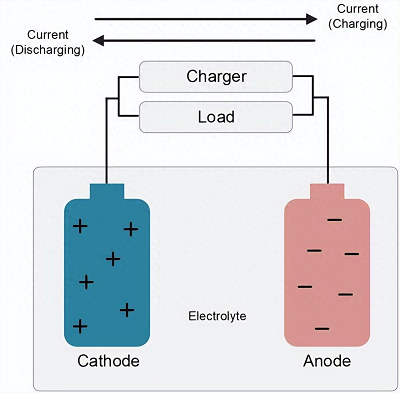Lithium-ion polymer battery charging secrets: revealing the scientific code of the optimal voltage and current
In an era when the fast charging power of smartphones exceeds 200W, people often only focus on the charging speed, but ignore the scientific logic behind the charging parameters. As the power heart of modern electronic devices, the charging management of lithium-ion polymer batteries can be called a precise human surgery - it is necessary to ensure energy delivery efficiency and maintain battery health. This article will deeply analyze the setting principle and practical value of its optimal charging parameters.

I. Charging voltage: the electrochemical code behind 4.2V
The standard charging termination voltage of lithium-ion polymer batteries is 4.2V±0.05V, and this value is determined by the physical limit of the electrode material. The crystal structure of the positive electrode lithium cobalt oxide (LiCoO₂) will collapse irreversibly when it exceeds 4.25V, and the lithium ion embedding limit of the graphite negative electrode corresponds to the voltage threshold of 4.2V. Laboratory studies have shown that for every 0.1V exceeding the nominal voltage, the battery cycle life will be shortened by 30%-40%.
High-voltage batteries (such as 4.35V/4.4V models) increase the voltage tolerance limit by about 4% by improving the positive electrode material (such as nickel-cobalt-manganese ternary material) and electrolyte formula. However, this type of battery must be used with a dedicated charger. Forcible pressure applied by ordinary chargers will cause the electrolyte to oxidize and decompose, producing a large amount of CO₂ gas and causing bulging.
II. Charging current: kinetic balance of the 0.5C rule
0.5C current (such as 1A current for a 2000mAh battery) is recognized as the best balance point. This rule is based on the kinetics of lithium ion migration:
Ion diffusion rate: At 25℃, the diffusion rate of lithium ions between graphite layers is 0.1-1μm/s. Excessive current causes ions to accumulate on the electrode surface, forming metallic lithium deposition (lithium precipitation effect).
Joule heat control: According to the Q=I²Rt formula, the heat generated by 1A current is 4 times that of 0.5A. Actual measured data shows that the battery temperature can rise by 15℃ during 2C fast charging compared to 0.5C charging.
Polarization phenomenon: large current leads to intensified concentration polarization, and the effective charging voltage needs to be increased by 0.1-0.3V to achieve the same SOC (state of charge), which will accelerate the decomposition of the electrolyte.
Fast charging technology (such as the 30W/65W protocol for mobile phones) avoids risks through a multi-stage strategy: charging to 50% of the power with a large current (1.5-2C) in the early stage, and switching to a gradient current reduction mode in the later stage. However, the capacity retention rate of batteries that use fast charging for a long time is 20%-30% lower than that of standard charging.
III. Temperature variables: dynamic regulator of charging parameters
The charging parameters of lithium batteries need to be adjusted dynamically with temperature, which is a key point that most users ignore:
Low temperature restricted area: charging below 0℃, the lithium ion migration rate drops by more than 60%, and forced charging will cause lithium dendrite growth. High-end BMS systems will automatically reduce the current to 0.2C at 5℃ and completely close the charging circuit at 0℃.
High temperature compensation: When the ambient temperature exceeds 45°C, the charging voltage needs to be reduced by 0.03V/°C. For example, at 50°C, the cut-off voltage should be adjusted to 4.15V. Tesla's battery thermal management system will automatically reduce the power of the super charging pile by 40% on hot days.
Internal resistance monitoring: The internal resistance of an aging battery increases by more than 50%. At this time, even if the standard current is used, the actual heat generation will double. Smart devices detect changes in internal resistance through a coulomb meter and dynamically optimize charging parameters.
IV. Charging practice: the golden rule for extending life
Shallow charge and discharge: Keeping the power in the range of 20%-80% can extend the cycle life to 3,000 times (compared to 500 times of 100% charge and discharge). Apple's iOS 13 "Optimized Battery Charging" function is based on this principle.
Pulse repair: Use 5% of the power once a month and then fully charge to calibrate the fuel gauge and eliminate the slight passivation layer. However, deep discharge cannot exceed 30 minutes.
Charger selection: Huawei's 40W super fast charging head has a built-in charge pump chip that can convert 10V/4A to 5V/8A, reducing the voltage stress at the battery end. The copycat charger lacks a voltage compensation module, and long-term use will cause overvoltage damage.
Wireless charging management: Qi standard 15W wireless charging has an energy conversion efficiency of only 70%, and the battery temperature rise is 8°C higher than wired charging. It is recommended as a backup solution.
V. Future trends: Breakthroughs in smart charging technology
New electrolyte technologies (such as semi-solid electrolytes) can increase the upper limit of charging voltage to 4.5V, and achieve 5C fast charging with silicon-carbon negative electrodes. The "self-healing diaphragm" technology developed by CATL can release repair agents to eliminate hidden dangers when lithium dendrites are detected. The lithium metal anode developed by the 2023 Nobel Prize in Chemistry winner is expected to increase charging efficiency to the theoretical limit.
While enjoying the convenience of technology, users need to establish a sense of "battery health management". Just as top sports cars require meticulous maintenance, the scientific charging of lithium-ion polymer batteries is the core code to extend the life cycle of digital devices. By understanding and practicing these charging rules, we can not only grasp the current pursuit of efficiency, but also safeguard the safety boundaries of the future.



